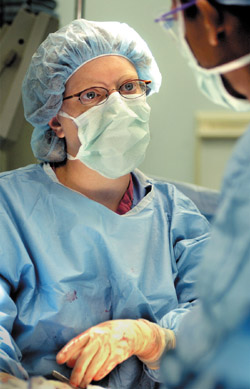
Dr. Kim Lomis instructs Meharry medical student Nick Strane during a recent colon surgery. (photo by Dana Johnson)
Surgery education committee steers new course at VUMC
The evolution of the health care delivery system has not only affected the more than 640,000 patient visits to Vanderbilt each year, it’s changed the way medical students like Andrew White learn, especially during the surgical rotation.
“One of the things we’re expected to learn is how to work up patients for a wide variety of surgical problems. But we rarely see (patients) present, so we’re not there for the continuous course of care they need,” said White, an third-year medical student from Albuquerque, N.M. “We learn a lot of OR skills, which is pretty cool.”
White’s point strikes a cord in medical education, especially in surgery. With changes in health care come challenges, says Dr. Kim Lomis, assistant professor of Surgery and director of the surgery clerkship. Patients used to spend a week in the hospital getting workups for surgery; now they often do that as an outpatient. Students miss the mystery of diagnosis and encounter patients when the sleuthing is complete.
“Instead of walking in to meet a patient and the patient saying, ‘I have a pain in my belly,’ the students walk in and the patient says, ‘Dr. So-and-so is taking out my gall bladder today,’” Lomis said.
The problem is a concern among educators. “If there’s a real set of data that says doctors are less qualified than in the past, I don’t think there is. … We have to learn how to teach students that process (of surgical workup) when they’re not participating in it,” Lomis said.
The Medical Student Education Committee in the Section of Surgical Sciences, which also falls under Lomis’ purview, is charged with shepherding students, and faculty, through the changes. The committee and a council of surgical subspecialists are comprised of a total of 21 physicians. “We were mainly concerned with providing a forum for the education of medical students,” Lomis said.
In quarterly meetings, the second of which comes in November, the committee will: review the students’ exam scores and address grading issues; gather, review and consider student feedback for changes to the program; adjust the curriculum as needed; provide faculty development; review the shelf exam; give feedback to faculty; and review educational research projects.
Not only are students encountering fewer chances to follow a patient through workup, but fewer students are becoming surgeons while the need for surgeons grows, a paradox that further widens the gap in education.
So, Lomis said, the curriculum is already changing, from one that focuses on OR skills to one that leaves students with the tools they need to decide if surgery is appropriate for a given patient. “Lectures will be more interactive, case-based discussions,” she said. “They’ll walk through the thought process with their peers. We’ll spend less time teaching the procedure, because most of them will not go into surgery. We’ll spend more time discussing the thought processes leading up to it.”
Medical students spend 10 weeks during their third year in the surgical clerkship; five weeks are spent on general surgery and five weeks are divided among their pick of two subspecialties.
The most immediate change, though, is an increased awareness of teaching directed to students, Lomis said. “We’re all pressured right now with time constraints,” Lomis said of her fellow faculty. Providing feedback to the faculty about their performance, giving them tips about effective, efficient teaching methods and conducting their own education research will help sharpen the focus and whittle away time burdens.
White said the clerkship swayed him to consider surgery as an option. He also said he’s encouraged by the committee and Lomis’ energy to tackle the challenges.
Other students, Lomis said, have noted the increased level of attention. “They’ve told me that having someone actively question how things work is very reassuring to them,” Lomis said. “They seem to be very forthright with their input.”













